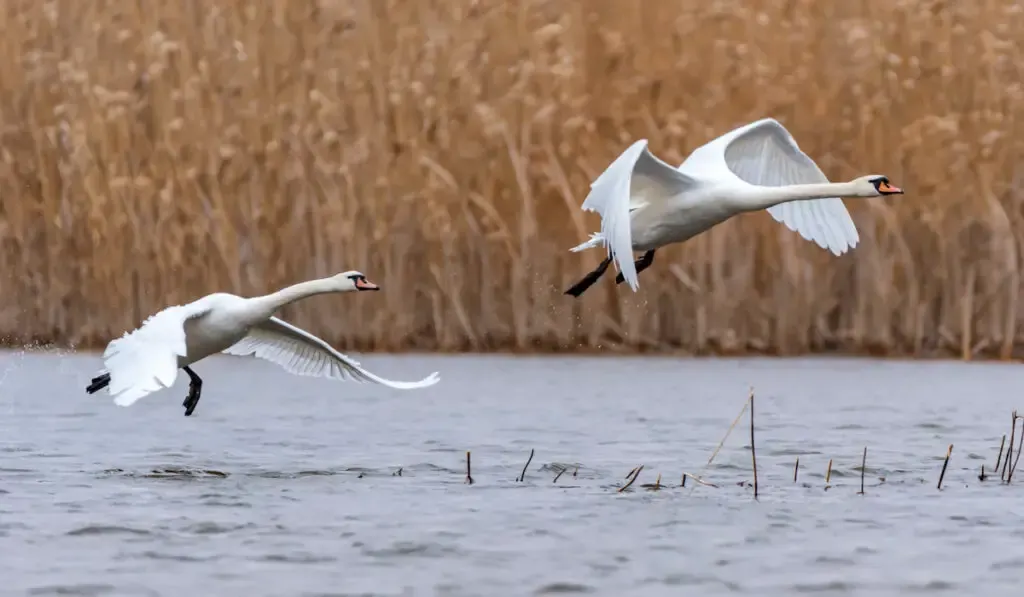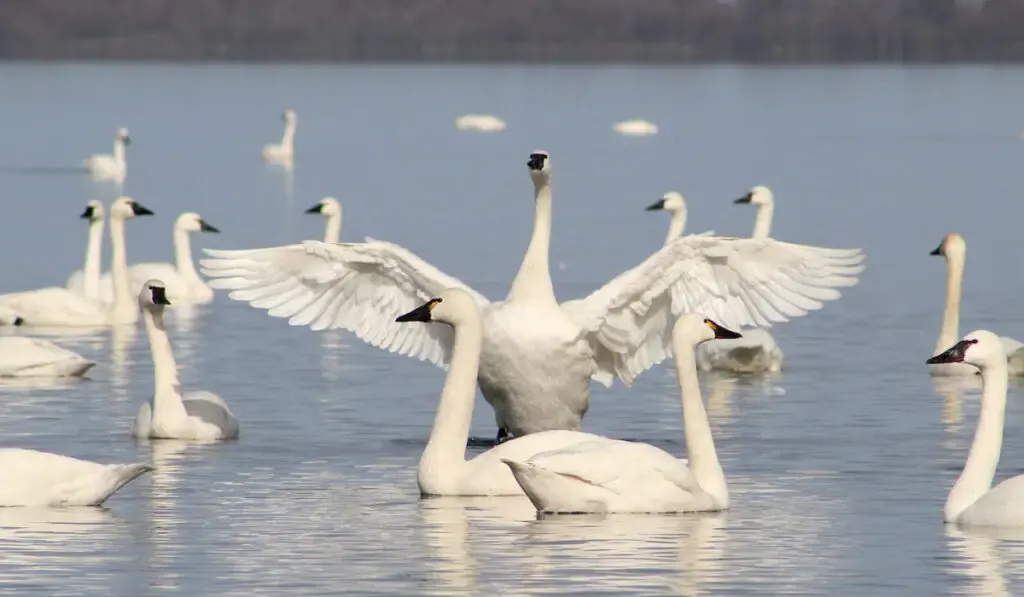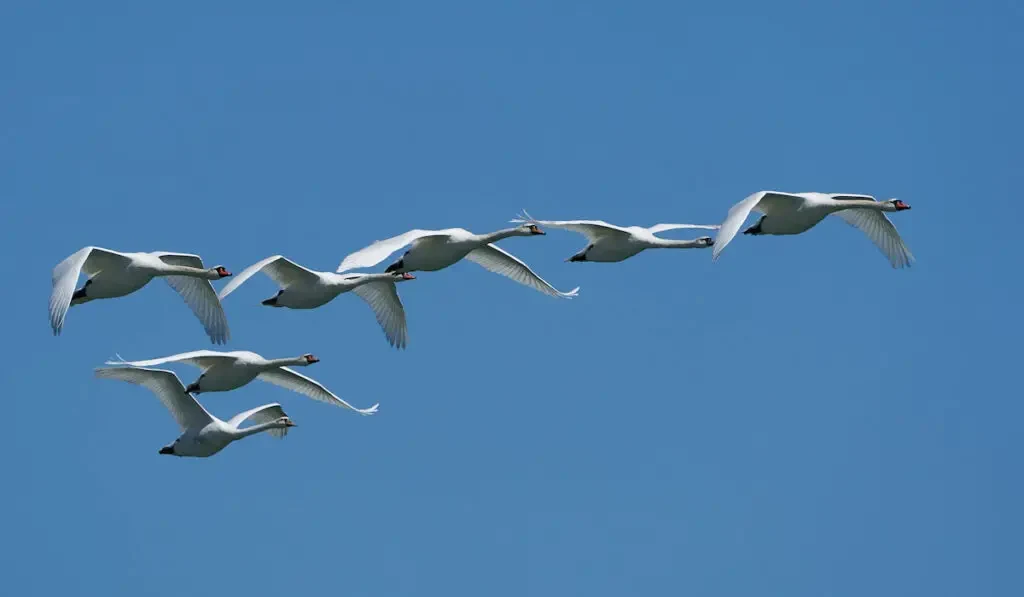Animals like bears hibernate to survive the winter, while animals like snails aestivate to survive hot or dry seasons. However, for most birds, survival during unfavorable seasons involves migration. Since all birds do not migrate, you might be unsure if swans are migratory too.
Do swans migrate?
Most species of swans are migratory to varying degrees. While some are entirely migratory, others only migrate partially.

Then there are species – like the Mute Swan and the Trumpeter Swan – that are principally non-migratory.
Going forward in this article, we discuss the seasons swans migrate, the direction in which they migrate, the migration pattern of different types of swans, and much more.
Table of Contents
Do Swans Migrate?
Like most other birds, swans migrate. However, you will find that while most species of swans are migratory, a few are not.
Of course, like the other migratory birds, swans migrate in search of food and milder weather.
In the Winter
North American Swans
Most species of swans typically migrate in the winter. Of the 7 species of swans in the world, 3 are present in North America. These 3 are the Trumpeter, the Tundra, and the Mute. Interestingly, of these 3, only the Tundra is fully migratory.
Tundra Swans are considered medium-distance migrants. They typically migrate southward from the arctic region or eastern Alaska in mid-September.
In winter, arctic region breeders migrate to estuaries in places like northern California and Vancouver Island. They also migrate to inland sites between Southern Idaho and the southern Colorado River.
On the other hand, eastern Alaskan breeders migrate to the coastal mid-Atlantic, the eastern Great Lakes, and various locations along the East Coast.
Some Tundra Swan subspecies go as far as Europe and Asia in winter.
Trumpeter Swans are typically non-migratory. However, you may find some that travel over short distances.
South American Swans
In South America, there are two main swan species: the Black-necked Swan and the Coscoroba Swan. These 2 species also migrate in the winter. Note that, unlike other swans, Coscoroba Swans do not belong to the Cygnus genus. So, they are often considered honorary swans.
The Black-necked Swans breed in Patagonia, the Falkland Islands, and Tierra del Fuego. Then when winter comes, they move north towards southern Brazil and Paraguay.
Like the Black-necked Swans, Coscoroba Swans breed in Tierra del Fuego. They also nest in southern Chile and central Argentina. In the winter, they travel northwards to central Chile, Paraguay, northern Argentina, southern Brazil, and Uruguay.

European Swans
Whooper Swans and Mute Swans can be found in Europe. But as we said earlier, Mute Swans are typically non-migratory. Whooper Swans, on the other hand, are migratory.
There are various populations of Whooper Swans, and each one breeds and winters in different locations.
The following are some Whooper Swan populations and their winter migration destinations:
- The Icelandic Whoopers spend winter in Ireland and Britain.
- The East Asian Whoopers migrate primarily to Japan in winter.
- The Northwest Continental European Whoopers move southwards in winter. So, they spend winter primarily in continental Europe.
- The Caspian/West and Central Siberia Whoopers spend winter between Lake Balkhash and the Caspian Sea.
In Flocks
As with other migratory birds, swans typically migrate in the aerodynamic V-formation. Of course, to achieve this, they have to fly in flocks.
The V-formation is one of the adaptations that allow birds to migrate over long distances.
In this formation, the bird at the apex of the V mitigates air resistance, making in-flight movement easier for birds behind it.
The birds take turns at the apex of the V, so one bird does not do all the work.
Which Direction (North or South)?
The direction in which swans migrate depends on their breeding region.
For one, Tundra Swans breed in eastern Alaska and the arctic region. Then when they migrate, they travel south where the weather is more favorable for them.
Unlike the Tundra Swans, Black-necked Swans and Coscoroba Swans migrate towards the north.
In the cases of Tundra Swans, Black-necked Swans, and Coscoroba Swans, you will notice that their migration patterns tend away from the poles and towards the equator. One possible explanation for this is that it gets warmer towards the equator.
For Whooper Swans, the general direction of migration for the different populations is the south. Iceland Whooper Swans go south to the UK and Ireland, where the winter is less intense.
East Asian Whooper Swans go south to Southern Japan, where winter is not as harsh. The same rationale applies to other populations of Whooper Swans in Europe and Asia.

From Michigan
Typically, Michigan is a migration corridor for Tundra Swans going towards the East Coast from Eastern Alaska. Tundra Swans take a stop at Saginaw Bay, Michigan. Then when it gets colder in Michigan, they resume their migration towards the east coast.
Apart from the above, Michigan has its own Tundra Swan population. In our search, we could not verify if this population of swans in Michigan migrates. However, since it is one of the coldest winter states in the US, these swans likely do migrate from Michigan.
From Ontario
As with Michigan, Ontario is a migration corridor for Tundra Swans. However, our search did not reveal that swans migrate from Ontario.
We did find out that Trumpeter Swans in Ontario migrate within the province. In winter, Trumpeter Swans have been observed migrating from North Bay, Kirkland Lake, and Wye Marsh to LaSalle Park, Burlington.
At Night
While migration might be more common during the day, swans can migrate at night. In fact, nocturnal migration is not limited to swans, as other waterfowl like ducks and geese can migrate at night, too.
Difference Between Migration Patterns for Different Types of Swans
Most types of swans have a seasonal migration pattern.
When winter comes, they move away from their breeding ranges towards regions with milder weather.
Plus, these movements peak in the fall and spring.
While other types of swans may follow the seasonal migration pattern, Black Swans do not. Black Swans follow a nomadic migration pattern, which depends on the availability of food and other resources.
Nomadic migration is opportunistic, so you will most likely only find Black Swans where there is abundance of what they like to eat.
Amongst the swans that seem to follow a seasonal migration pattern, there are some differences too. For one, Tundra swans migrate towards the south. On the other hand, Black-necked Swans and Coscoroba Swans migrate towards the north. Nonetheless, both migration patterns are latitudinal.
Trumpeters can also be said to migrate seasonally. But their migration is not latitudinal like the Tundra, Coscoroba, and Black-necked. Trumpeter Swans migrate only short distances, typically within the same region.
Whooper Swans also follow a seasonal migration pattern. However, their movement from Iceland to Ireland and the UK is the longest sea-crossing amongst swan species.
The Mute Swans of North America are non-migratory, but some populations in Europe migrate in a seasonal pattern. And unlike the other swan species, the migration takes the swans to another continent.

Final Thoughts
Swans are generally migratory. Although amongst the species, you will find variations. Tundra, Whooper, Coscoroba, and Black-necked Swans do migrate. However, Mute Swans in North America are non-migratory, while Black Swans are nomadic. Then Trumpeter Swans, although principally non-migratory, will migrate over short distances.
Resources
- https://www.aphis.usda.gov/wildlife_damage/reports/Wildlife
- https://www.csmonitor.com/1998/0929/092998.home.home.1.html
- https://rangerplanet.com/where-do-swans-go-in-the-winter-migration-guide-of-most-common-swans/
- https://www.thespruce.com/types-of-swan-species-385430
- https://www.fws.gov/species/species_accounts/bio_swan.html
- https://www.allaboutbirds.org/guide/Tundra_Swan/maps-range
- https://animaldiversity.org/accounts/Cygnus_melancoryphus/
- https://www.beautyofbirds.com/coscorobaswans.html
- https://www.cs.mcgill.ca/~rwest/wikispeedia/wpcd/wp/s/Swan.htm
- https://swansg.org/the-swans/whooper/
- https://www.lambtonmuseums.ca/en/lambton-heritage-museum/tundra-swan-migration.aspx
- https://content.govdelivery.com/accounts/MIDNR/bulletins/5f9e69
- https://www.thestar.com/news/ontario/2009/03/29/trumpeter_swans_making_a_comeback_in_ontario.html
- https://www.audubon.org/field-guide/bird/trumpeter-swan
- https://www.allaboutbirds.org/news/is-it-possible-ive-heard-a-whole-flock-of-swans-migrating-overhead-late-at-night/
- https://wildlifepark.novascotia.ca/animals/black-swan.asp
- https://www.thespruce.com/types-of-bird-migration-386055
- https://monitoring.wwt.org.uk/our-work/goose-swan-monitoring-programme/species-accounts/whooper-swan/
